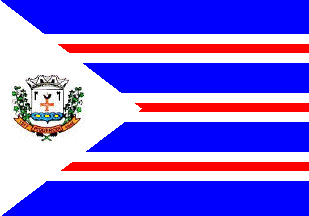 image by Ivan Sache,
1 March 2013
image by Ivan Sache,
1 March 2013Based on: http://pt.wikipedia.org/wiki/Rancharia

Last modified: 2013-03-23 by ian macdonald
Keywords: sao paulo | piquerobi |
Links: FOTW homepage |
search |
disclaimer and copyright |
write us |
mirrors
 image by Ivan Sache,
1 March 2013
image by Ivan Sache,
1 March 2013
Based on:
http://pt.wikipedia.org/wiki/Rancharia
Piquerobi was founded around 1917. The first colonists were Miguel
Carmona, Domingos Tacone, Ambrósio and Julian Garcia, and Mário
Fairbanks, who acquired plots from Arthur Ramos e Silva Junior,
Colonel Manoel Pinheiro and Sooma Issamo. A railway station was
inaugurated on 14 July 1921 by he Sorocabana Railway, which boosted
the development of the town. The district of Piquerobi was established
in 1928 by Law No; 2,294.
The municipality of Piquerobi was established by Law No. 233 of 24
December 1948 and inaugurated on 1 January 1949.
Piquerobi is named for Piquerobi Witacker de Aguiar, State Secretary
of Justice in 1946, who ordered the land survey of the region.
http://www.piquerobi.sp.gov.br - Municipal website
The symbols of Piquerobi are prescribed in Article 3 of the Municipal
Constitution, as "the flag, the coat of arms and the anthem
established by law".
http://www.cmpiquerobi.sp.gov.br/leiorganica.pdf - Municipal
Constitution
The flag was designed by Arcinóe Antônio Peixoto de Faria in compliance with the traditions of Brazilian heraldry, The flag is blue with three horizontal white-red-white stripes. A white triangle is placed along the hoist and charged with the municipal coat of arms.
The dimensions of the flag are 14 units x 20 units. The coat of arms represents the municipal government, while the triangle that inscribes it represents the town as the seat of the municipality. The triangle is a symbol of liberty, equality and fraternity. White is a symbol of peace, friendship, work, prosperity, purity and religious feeling. The horizontal stripes represent the municipal power spreading all over the municipal territory. Red is a symbol of dedication, patriotic love, audacity, intrepidity, courage and valiance. The quarters represent the rural estates located on the municipal territory. Blue is a symbol of justice, nobleness, perseverance, zeal and loyalty.
http://camarapprudente.sp.gov.br/historia/hist_oeste/cidades/piquerobi/simbolos\ .html > - "Enciclopédia Digital de Oeste Paulista" website
Photos of the flag:
http://toninhomore.blogspot.fr/2012/10/entrevista.html
http://www.cmpiquerobi.sp.gov.br/verea.html
http://www.cmpiquerobi.sp.gov.br/fotos_galeria/pages/Posse%20de%20Piquerobi%20(103).htm
The coat of arms is "A Samnitic shield surmounted by a six-towered mural crown argent. Argent a cross patty gules voided ensigned with a hunting horn sable and surrounded by two axes of the same a base azure wavy argent three fish naiant or. The shield supported dexter by a branch of cotton and sinister by a plant of groundnut the two proper. Beneath the shield a scroll gules inscribed with the municipality's name surrounded by the years '1917' and '1948' all argent."
The Samnitic shield, the first style of shield introduced in Portugal from France and inherited by the Brazilian heraldry, evokes the colonizing race that mainly built our nation. The six-towered mural crown argent represents a third-rank town, seat of a municipality. Argent is a symbol of peace, friendship, work, prosperity, purity and religious feeling. The cross patty gules evokes the Christian faith of people and the chapel dedicated to St. Michael erected in 1928 by Miguel Carmona. The cross patty was also used by the Portuguese seamen on the sails of their ships, and by the pioneers during the conquest of the hinterland. The hunting horn represents cattle breeding, one of the main sources of income of the municipality, while the axes recall the clearings of the forest made around 1917 to establish rural estates. Sable is a symbol of austerity, prudence, knowledge, moderation and strong- mindedness. The base of the shield represents Fish River (rio do Peixe), recalling that the town was established in its valley. Azure is a symbol of justice, nobleness, perseverance, zeal and loyalty. Or is a symbol of glory, splendour, greatness, wealth and sovereignty. The branch of cotton and the plant of groundnut represent the main products of the generous and fertile soil, being the main source of income for the municipality. The years on the scroll recall the great clearings and the political and administrative emancipation, respectively.
http://camarapprudente.sp.gov.br/historia/hist_oeste/cidades/piquerobi/simbolos.html - "Enciclopédia Digital de Oeste Paulista" website